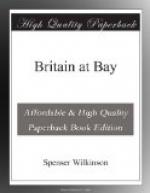The doubt whether victory has been borne in mind is confirmed by what is known of the design of the original Dreadnought. A battleship ought to be constructed for battle, that is, for the purpose of destroying the enemy’s fleet, for which purpose it will never be used alone, but in conjunction with a number of ships like itself forming the weapon of an admiral in command. A battleship requires three qualities, in the following order of importance:—
First, offensive power. A fleet exists in order to destroy the enemy, but it has no prospect of performing that function if its power of destruction is less than its enemy’s. The chief weapon to-day, as in the past, is artillery. Accordingly the first requisite of a fleet, as regards its material qualities, those produced by the constructor, is the capacity to pour on to the enemy’s fleet a heavier rain of projectiles than he can return.
The second quality is the power of movement. The advantage of superior speed in a fleet—for the superior speed of an individual ship is of little importance—is that so long as it is preserved it enables the admiral, within limits, to accept or decline battle according to his own judgment. This is a great strategical advantage. It may in some conditions enable an inferior fleet to postpone an action which might be disastrous until it has effected a junction with another fleet belonging to its own side.
The third quality is that the ships of a fleet should be strong enough to offer to the enemy’s projectiles a sufficient resistance to make it improbable that they can be sunk before having inflicted their fair share of damage on the adversary.
There is always a difficulty in combining these qualities in a given ship, because as a ship weighs the quantity of water which she displaces, a ship of any given size has its weight given, and the designer cannot exceed that limit of weight. He must divide it between guns with their ammunition, engines with their coal, and armour. Every ton given to armour diminishes the tonnage possible for guns and engines, and, given a minimum for armour, every extra ton given to engines and coal reduces the possible weight of guns and ammunition. In the Dreadnought a very great effort was made to obtain a considerable extra speed over that of all other battleships. This extra speed was defended on the ground that it would enable a fleet of Dreadnoughts to fight a battle at long range, and with a view to such battle the Dreadnought




